It would be fantastic if PfE used this multi channel thing. I will ask Cameca about this next time I'll talk to them. Is it possible to reverse engineer that?
No need, Cameca has provided the protocols for the PHA MCA call, so I will implement it ASAP.
Ok, I also think it might be cool to test which one is better, Mb or overlap correction. But how would I test the quality of the data?
I would try some standards. There will be lower precision with the Mb line since the intensity is lower. As for the interference correction it is worth mentioning that when you have a significant overlap to correct, be sure to use the Use Unknown Count Time For Interf. Std option in the Acquisition Options dialog as seen here:

This allows the program to calibrate the interference overlap using the same precision as your unknowns. Normally these are the same, but if the element in the unknown is at a minor or trace level and therefore one is utilizing the Unknown Count Factor feature to count longer on the unknowns than the standards, this will insure that the precision of the interference correction is equal to the precision of the unknown measurement.
What about L lines then? There are some cases where we use Lb, for Cs for example. There is some nasty overlap.
My question is, is it always possible to correct? In theory yes, right? As long one has the proper standards for measuring the correction values. It would be interesting to try this on Cs for example. I should check how many counts I will gain using Cs La.
I have not found a situation where the quantitative interference correction in PFE did not work as expected as long as proper standards are available for the interference overlap calibration.
I agree that oxygen interferences can be problematic, for example, Ti Lb interfering with oxygen because it is difficult to find a Ti standard that does not have some bulk oxygen. However, now that we have obtained some iodine vapor grown Ti crystals, as long as we polish the standard mount just prior to measurement, we can correct for this overlap very nicely.
Interference by Al SKBX III at 23.8690 = 14.5%
Interference by Ti LB3 at 23.8890 = 676.2%
Interference by Ti LB4 at 23.8890 = 354.4%
Interference by Al KB1 III at 23.9500 = 17.2%